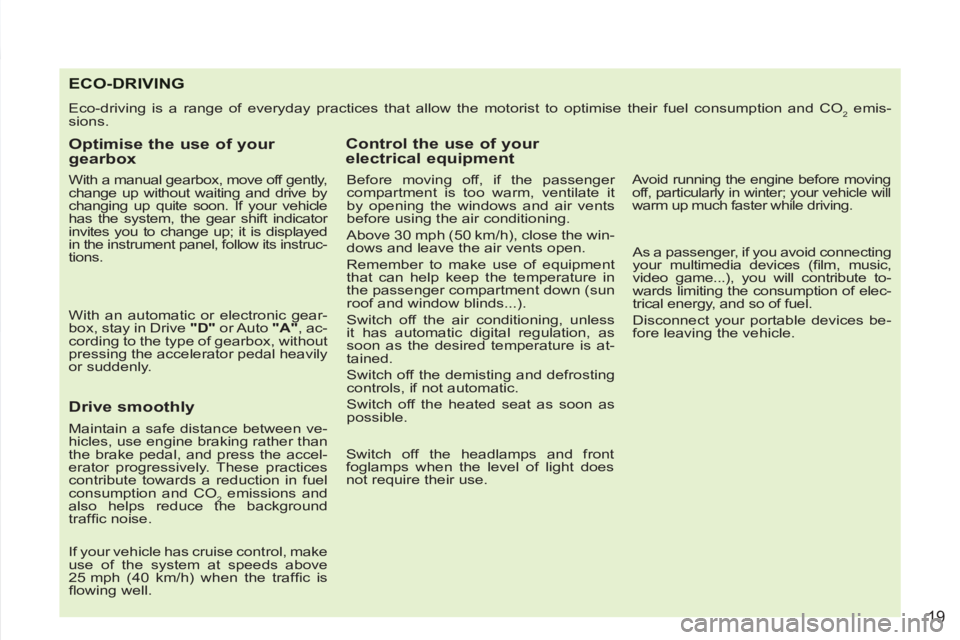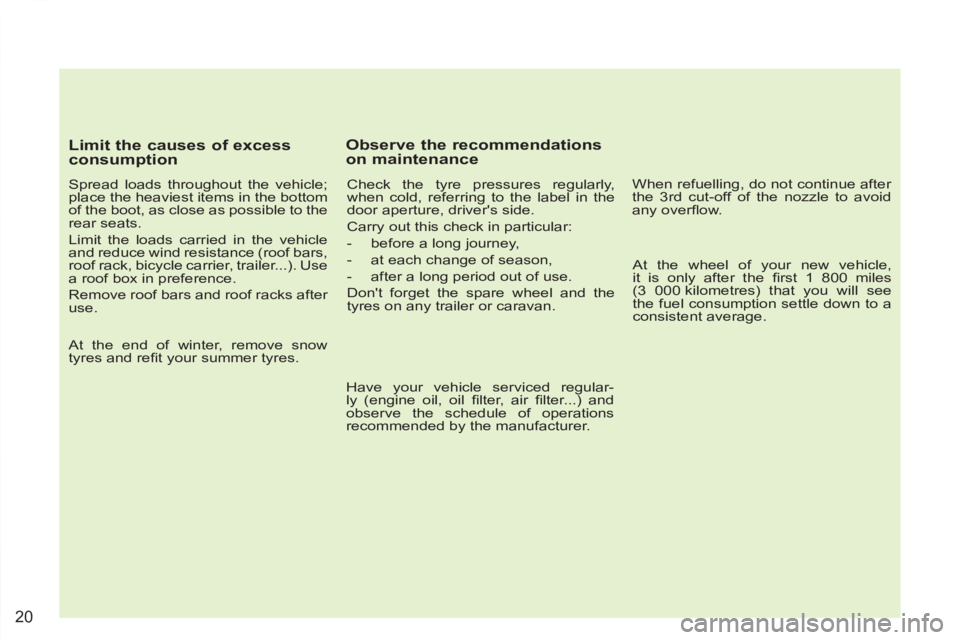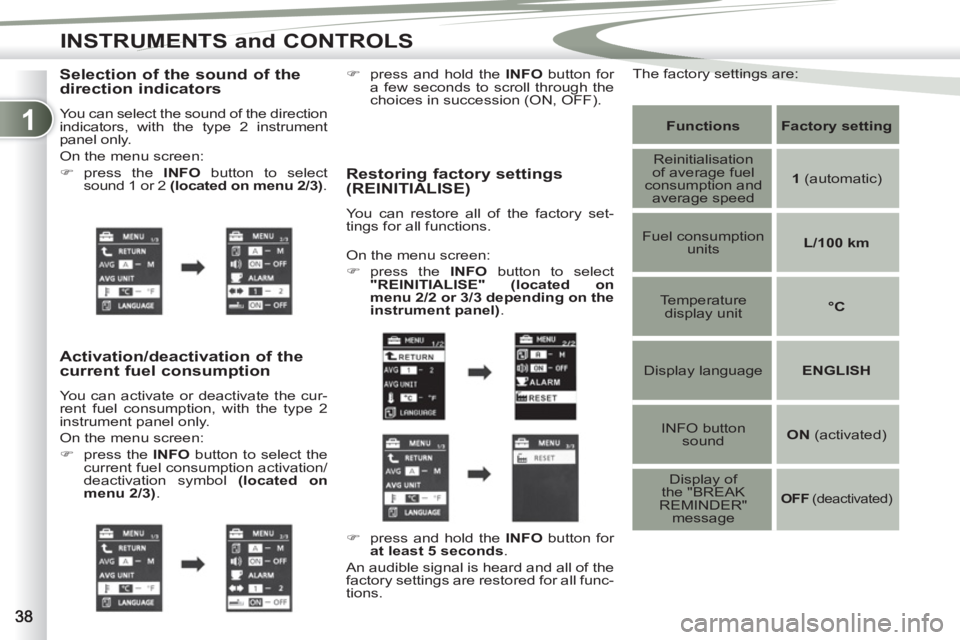2012 PEUGEOT 4007 fuel consumption
[x] Cancel search: fuel consumptionPage 21 of 236

19
ECO-DRIVING
Eco-driving is a range of everyday practices that allow the motorist to optimise their fuel consumption and CO2 emis-
sions.
Optimise the use of your
gearbox
With a manual gearbox, move off gently,
change up without waiting and drive by
changing up quite soon. If your vehicle
has the system, the gear shift indicator
invites you to change up; it is displayed
in the instrument panel, follow its instruc-
tions.
With an automatic or electronic gear-
box, stay in Drive "D"
or Auto "A"
, ac-
cording to the type of gearbox, without
pressing the accelerator pedal heavily
or suddenly.
Drive smoothly
Maintain a safe distance between ve-
hicles, use engine braking rather than
the brake pedal, and press the accel-
erator progressively. These practices
contribute towards a reduction in fuel
consumption and CO
2 emissions and
also helps reduce the background
traffi c noise.
If your vehicle has cruise control, make
use of the system at speeds above
25 mph (40 km/h) when the traffi c is
fl owing well.
Control the use of your
electrical equipment
Before moving off, if the passenger
compartment is too warm, ventilate it
by opening the windows and air vents
before using the air conditioning.
Above 30 mph (50 km/h), close the win-
dows and leave the air vents open.
Remember to make use of equipment
that can help keep the temperature in
the passenger compartment down (sun
roof and window blinds...).
Switch off the air conditioning, unless
it has automatic digital regulation, as
soon as the desired temperature is at-
tained.
Switch off the demisting and defrosting
controls, if not automatic.
Switch off the heated seat as soon as
possible.
Switch off the headlamps and front
foglamps when the level of light does
not require their use.
Avoid running the engine before moving
off, particularly in winter; your vehicle will
warm up much faster while driving.
As a passenger, if you avoid connecting
your multimedia devices (fi lm, music,
video game...), you will contribute to-
wards limiting the consumption of elec-
trical energy, and so of fuel.
Disconnect your portable devices be-
fore leaving the vehicle.
Page 22 of 236

20
Limit the causes of excess
consumption
Spread loads throughout the vehicle;
place the heaviest items in the bottom
of the boot, as close as possible to the
rear seats.
Limit the loads carried in the vehicle
and reduce wind resistance (roof bars,
roof rack, bicycle carrier, trailer...). Use
a roof box in preference.
Remove roof bars and roof racks after
use.
At the end of winter, remove snow
tyres and refi t your summer tyres.
Observe the recommendations
on maintenance
Check the tyre pressures regularly,
when cold, referring to the label in the
door aperture, driver's side.
Carry out this check in particular:
- before a long journey,
- at each change of season,
- after a long period out of use.
Don't forget the spare wheel and the
tyres on any trailer or caravan.
Have your vehicle serviced regular-
ly (engine oil, oil fi lter, air fi lter...) and
observe the schedule of operations
recommended by the manufacturer.
When refuelling, do not continue after
the 3 rd cut-off of the nozzle to avoid
any overfl ow.
At the wheel of your new vehicle,
it is only after the fi rst 1 800 miles
(3 000 kilometres) that you will see
the fuel consumption settle down to a
consistent average.
Page 33 of 236

1
INSTRUMENTS and CONTROLS
The total distance is dis-
played in zone 1
of the
screen and the trip dis-
tance in zone 2
(refer to
the "Distance recorders"
section).
Distance recorder (A and B)
INFORMATION ON TINFORMATION ON THE
INSTRUMENT PANEL SCREEN
Information display
With the ignition on, press the INFO
but-
ton, located on the fascia to the left of the
instrument panel, to display the various
types of information in succession:
- distance recorder A,
- distance recorder B,
- service indicator,
- coolant temperature,
- range,
- trip computer,
- setting menu.
This displays the dis-
tance and the number
of months remaining be-
fore the next service, in
line with the manufactur-
er's servicing schedule
(refer to the "Service in-
dicator" section).
Service indicator
When the engine is run-
ning, this indicates the
temperature of the cool-
ant (refer to the "Coolant
temperature indicator"
section).
Coolant temperature When the engine is run-
ning, this indicates the
number of miles (kilo-
metres) which can still
be travelled with the fuel
remaining in the tank,
based on the average
fuel consumption over
the last few miles (kilometres) travelled
(refer to the "Range" section).
Range
This indicates the aver-
age fuel consumption,
the average speed and
the current fuel con-
sumption (refer to the
"Trip computer" section).
Trip computer
When the vehicle is
stationary
, this allows
the user to change the
following settings (refer
to the "Setting menu"
section):
- the display language,
- the temperature dis-
play units,
- the fuel consumption units,
- the option to reinitialise the average
fuel consumption and the average
speed,
- the break (rest) reminder display
interval.
Setting menu
Page 34 of 236

1
INSTRUMENTS and CONTROLS
The total distance is dis-
played in zone 1
of the
screen and the trip dis-
tance in zone 2
.
DISTANCE RECORDERS (A/B)
System for measuring the total distance
travelled by the vehicle during its ser-
vice life and the distance travelled in
a day or other period until it is reset to
zero by the driver.
Zero reset
With the ignition on, press the INFO
button for more than 2 seconds until
zeros appear.
When the engine is run-
ning, this indicates the tem-
perature of the coolant.
COOLANT TEMPERATURE
If the bar is close to the critical
position
located on the right, the temperature is
too high.
The symbol fl ashes when your engine
is overheating.
You must stop your vehicle as soon
as it is safe to do so.
Wait a few minutes before switching
off the engine.
Wait for the engine to cool be-
fore topping up the level. The
cooling system is pressurised.
When the engine is
running
, this indicates
the distance which can
still be travelled with
the fuel remaining in the
tank based on the aver-
age fuel consumption
over the last few miles/
kilometres travelled.
RANGEGE
When the range is less than 30 miles
(50 km)
, dashes are displayed.
Refuel as soon as possible. The display
of the range is updated.
To avoid any risk of scalding,
unscrew the cap by two turns to
allow the pressure to drop.
When the pressure has dropped, remove the cap and top up the
level, if necessary.
Contact a PEUGEOT dealer or
a qualifi ed workshop. This fi gure may increase fol-
lowing a change in the style of
driving or the relief, resulting in
a reduction in the current fuel
consumption.
If you only add a few litres, the
value displayed will be incorrect.
Therefore, you must fi ll the tank
whenever possible.
When you disconnect the bat-
tery, the previous fuel consump-
tion data is lost and the value
displayed will be different from
that displayed before the battery was disconnected. The distance
displayed must be considered
an approximate indication.
Page 36 of 236

1
INSTRUMENTS and CONTROLS
TRIP COMPUTER
Average fuel
consumption
(l/100 km or km/l or
mpg)
This is the average fuel
consumption since the
last zero reset.
This fi gure may change follow-
ing a change in the style of driv-
ing or the relief resulting in an
increase or decrease in the cur-
rent fuel consumption.
Average speed (km/h
or mph)
This is the average
speed calculated since
the last zero reset.
Resetting the information to zero
When the ignition is switched on, the
zero reset switches automatically from
manual mode to automatic mode.
If dashes "---" are displayed
for long periods in place of the
digits while driving, contact a
PEUGEOT dealer or a qualifi ed
workshop.
Current fuel
consumption
(l/100 km or km/l or
mpg)
This is the average fuel
consumption during the last
few seconds of driving.
Information display
With the ignition on, press the INFO
button on the dashboard, to the left of
the instrument panel, several times in
succession to display the different infor-
mation:
- average fuel consumption,
- average speed,
- current fuel consumption. When the required information is dis-
played, press the INFO
button for more
than two seconds to reset all of the in-
formation to zero.
Automatic
If the ignition key remains in the OFF
position for more than 4 hours, the in-
formation is reset to zero automatically.
Page 37 of 236

1
INSTRUMENTS and CONTROLS
When the vehicle is
stationary
, it allows the
user to change the fol-
lowing settings:
- the choice of the reini-
tialisation of the aver-
age fuel consumption
and average speed,
- the fuel consumption units,
- the temperature display unit,
- the display language,
- activation/deactivation of the INFO
button sound,
- the break (rest) reminder display in-
terval,
- restore the factory settings.
SETTING MENU
SETTING MENU
System which provides access to the
settings for certain functions.
The various menus may change be-
tween the type 1 instrument panel and
the type 2 instrument panel.
With the ignition on
, press the INFO
button on the dashboard, to the left of
the instrument panel, several times in
succession until the "SETTING MENU"
screen is displayed.
To change the settings, you
must stop the vehicle and switch
on the ignition.
Apply the parking brake and
place the gear lever in neutral.
When the vehicle is moving
,
the function settings are not
displayed when you press the
INFO
button.
Operation
�)
press and hold the INFO
button for
a few seconds to display the menu
screen.
Press and hold the INFO
button
for a few seconds to return to
the previous screen.
When the menu screen is
displayed, if no operation is
carried out within 15 seconds,
the Setting Menu screen is dis-
played.
�)
on the menu screen, press the INFO
button to select a function from the
list:
MENU
2/3:
- a/b
(option of displaying a different
language on the instrument panel
screen and the navigation screen),
- activation/deactivation of the
INFO
button sound
,
- ALERT
(changing of the "BREAK
REMINDER" display interval),
- selection of the sound
of the di-
rection indicators,
- activation/deactivation of the cur-
rent fuel consumption
,
MENU
1/3
:
- 1 - 2
(choice of the type of reinitiali-
sation of average fuel consumption
and average speed),
- UNIT
(choice of the fuel consumption
units),
- choice of the temperature display
unit
,
- LANGUAGE
(option of the display
language),
MENU 3/3:
- REINITIALISE
(restore factory set-
tings).
Page 38 of 236

1
INSTRUMENTS and CONTROLS
Choice of the fuel consumption
units
You can choose between different units
for displaying fuel consumption. On the menus screen:
�)
press the INFO
button to select
"UNIT"
.
�)
press and hold the INFO
button for
a few seconds to display the "UNIT"
screen.
�)
press the INFO
button to scroll the
units (km/L, L/100 km, mpg (US),
mpg (UK) and PREVIOUS) in suc-
cession.
�)
press and hold the INFO
button for
a few seconds to confi rm your se-
lection. In this case, the distance, speed and
quantity of fuel units will also be changed
in accordance with your choice of fuel
consumption unit. If the battery is disconnected,
the settings memory is cleared
and the default unit (km/L) is re-
stored automatically.
Choice of the temperature
display unit
You can choose between different units
for displaying the temperature.
On the menu screen:
�)
press the INFO
button to se-
lect the temperature unit set-
ting symbol (thermometer).
�)
press and hold the INFO
button for
a few seconds to scroll the units
(°C and °F) in succession.
The mode selected is confi rmed.
If the battery is disconnected,
the settings memory is cleared
and the default unit (°C) is re-
stored automatically.
Choice of the reinitialisation of
the average consumption and
average speed
You can choose between two average
fuel consumption and average speed
reinitialisation modes:
- automatic reinitialisation (
choice 1)
,
- manual reinitialisation (choice 2)
.
On the menu screen:
�)
press the INFO
button to select:
�)
press and hold the INFO
button for
a few seconds to switch in succes-
sion from reinitialisation mode 1
(au-
tomatic)
to reinitialisation mode 2
(manual)
.
The mode selected is confi rmed.
Page 40 of 236

1
INSTRUMENTS and CONTROLS
Selection of the sound of the
direction indicators
You can select the sound of the direction
indicators, with the type 2 instrument
panel only.
On the menu screen:
�)
press the INFO
button to select
sound 1 or 2 (located on menu 2/3)
.
Activation/deactivation of the
current fuel consumption
You can activate or deactivate the cur-
rent fuel consumption, with the type 2
instrument panel only.
On the menu screen:
�)
press the INFO
button to select the
current fuel consumption activation/
deactivation symbol (located on
menu 2/3)
.
Restoring factory settings
(REINITIALISE)
You can restore all of the factory set-
tings for all functions.
Functions
Factory
setting
Reinitialisation
of average fuel
consumption and
average speed
1
(automatic)
Fuel consumption
units
L/100 km
Temperature
display unit
°C
Display language
ENGLISH
INFO button
sound
ON
(activated)
Display of
the "BREAK
REMINDER"
message
OFF
(deactivated)
On the menu screen:
�)
press the INFO
button to select
"REINITIALISE"
(located on
menu 2/2 or 3/3 depending on the
instrument panel)
.
�)
press and hold the INFO
button for
at least 5 seconds
.
An audible signal is heard and all of the
factory settings are restored for all func-
tions.
�)
press and hold the INFO
button for
a few seconds to scroll through the
choices in succession (ON, OFF).
The factory settings are: